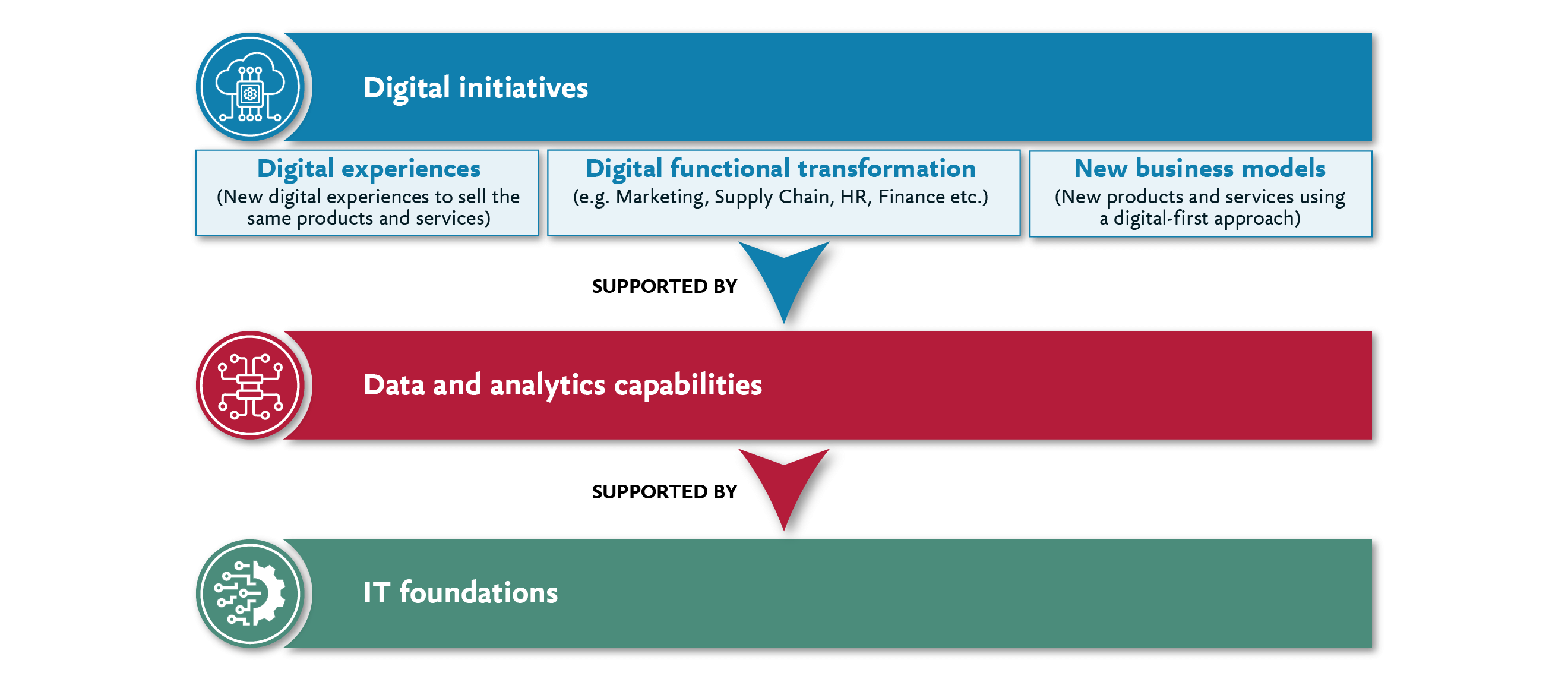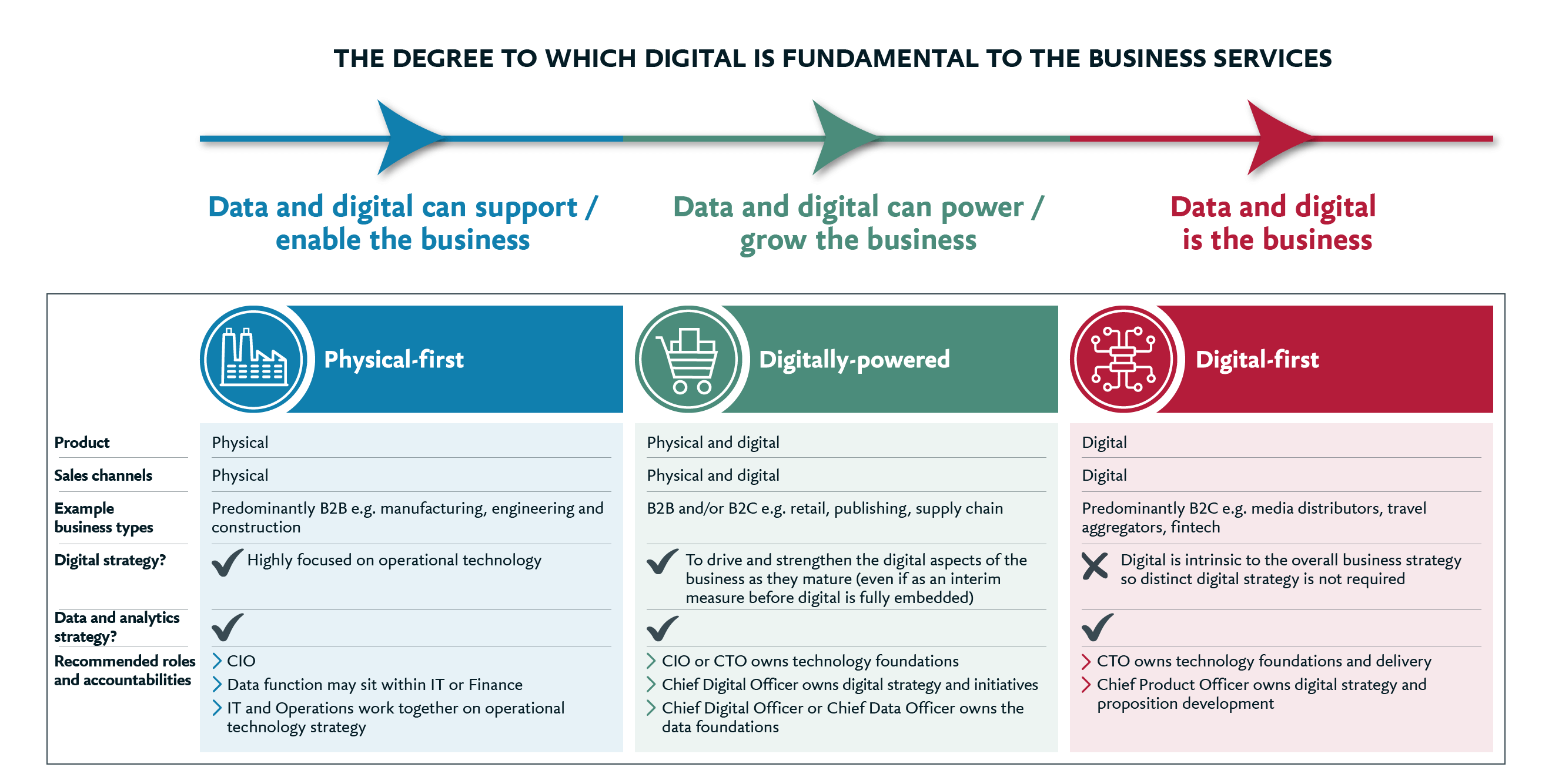At the heart of any digital initiative or project, data is used to drive better business performance. Without data, there is no digital. But many companies lack real clarity on how digital, data and technology should fit together, which can hinder clear strategy in these areas and/or lead to confused organisation structures and operating models.
We explore the relationship between IT, digital, data and analytics and discuss some of the factors you need to consider.
Governance and accountability for IT, digital, data and analytics
Many organizations wrestle with where digital initiatives should sit within the organization and who should take accountability. Do you need both a Chief Digital Officer and a Chief Data Officer? Or should all responsibility lie with a Chief Information Officer (CIO)?

Deciding on these roles and responsibilities usually requires examining three key areas:
- Information technology (IT) foundations (e.g. cloud platforms, ERP systems)
- Data and analytics capabilities (e.g. data platforms, analytics and AI tools, data scientists)
- Digital initiatives (which include new digital experiences to sell the same products and services; Digital transformation of internal functions; and new digital business models).
Each ‘layer’ supports the next in turn. Whichever organization structure you choose, there must be clarity of ownership for each layer. Above all, there needs to be clarity on the fundamental question of who ultimately owns the delivery of the capability that drives business outcomes.
The specific organization choices on the top-level roles are likely to be influenced by the type of organization.
The digital, data and analytics needs of different types of organization
Different types of organizations will have different requirements for their digital and data strategies, with varying levels of ‘need’. A helpful starting point is to consider where your organization lies on the spectrum between predominantly physical to a fully digital business.

At the left end of the spectrum above, you’ll find ‘physical-first’ businesses where the product is physical in nature and is sold through physical channels. These are typically B2B, such as a manufacturing or engineering business that produces construction materials, for example.
For such organizations, a digital strategy is more likely to be focussed on the operational technology – such as Internet of Things (IoT) supply chain technology – or the introduction of advanced or artificial intelligence (AI)-enabled analytics e.g. to improve demand forecasting, route and load optimisation, or quality control. These companies can still use data to drive business performance in other areas, for example to understand cost-to-serve and optimize profitability. This means such companies still need an enterprise-wide data strategy to ensure they utilise their data to improve business performance in all areas.
At the other end of the scale, ’digital-first’ businesses offer only digital goods or services, typically in a B2C context. Perhaps surprisingly, such organizations are unlikely to require a distinct digital strategy. This is because digital is intrinsic to the overall business strategy - so the business strategy is the digital strategy. There will still be a strong requirement for a robust data strategy, including the effective use of AI to enable better decision-making e.g. across areas such as customer experience, product enhancement and business operations.
Many organizations will find themselves somewhere in the middle of these two extremes. For example:
- Most retailers now operate through both physical locations and digital channels.
- Supply chain businesses are starting to generate real time insights to add new value to customers.
- Manufacturers of physical products may be able to generate deeper insight and loyalty through digital twins of their products.
Businesses like these will often require a distinct digital strategy to drive and strengthen the digital aspects of their business as they mature, even if as an interim measure before digital becomes fully embedded. They will also require a data strategy that enables the digital business model and other enterprise capabilities.
Returning to the topic of which top-level roles should exist and how their accountabilities should be arranged:
- Physical-first typically need a CIO and a good data function that may sit within IT or Finance. IT and Operations should work together to define the operational technology strategy and roadmap.
- Digitally-powered businesses typically need a CIO / CTO to own the technology foundations, and a Chief Digital Officer owning the digital strategy and initiatives. The Chief Digital Officer may also own the data foundations, or there may be a separate Chief Data Officer.
- Digital-first businesses typically need a CTO to own the technology foundations and drive great technology delivery. But digital strategy and proposition development is typically in the business and is owned by a Chief Product Officer for each business line.
If there is a Chief Digital Officer, this role typically owns delivery of the capability that drives business outcomes, as ‘digital’ is ultimately what you do with the data and technology. Organizations would then need to be aware that the CIO and Chief Data Officer are playing supporting or enabling roles for digital, potentially reporting to the Chief Digital Officer, although they may also have ‘non-digital’ responsibilities.
The key point is to be clear on who owns delivering the capability that is directly linked to driving business outcomes, versus who is playing an important role in delivering an enabling or supporting capability (like the underlying technology and data platforms). Whichever structure you choose, bear in mind that establishing all these roles as peers without that clarity is usually a poor model. It will create confusion over who is ultimately accountable for delivering the capabilities that the business needs to drive performance.
Should you start with a digital or data and analytics strategy first?
If you’ve determined you need both a digital and a data and analytics strategy, it’s not always clear which you should tackle first. Or do you try to do both at the same time? Deciding on the best approach is a common challenge for many businesses.
In an ideal scenario, organizations would set their digital strategy before moving on to the data and analytics strategy. A digital strategy will drive the use cases for your data. This then puts you in a better position to assess the data and analytics capabilities you need to build and how to deliver them, including the ways your business could leverage and exploit AI.
In practice, it's not quite as simple as that. Organizations will already be working with their data in various ways, requiring some level of data strategy. To cover your bases, you need to do enough to feel secure about what you’re doing with data and analytics today.
Then, when you develop a digital strategy, you will typically develop a much better understanding of how data can help your business. Developing more sophisticated use cases will enable you to use data and analytics to drive your business forward. At this point you should consider revisiting and revising your data strategy accordingly.
What’s the best operating model for digital, data and analytics?
The spectrum assessment can also help organizations begin to consider their target operating models.
A digitally native business will have an inherently digital culture. Digital is not a siloed function or job description because digital is inherent to what all people do throughout the organization.
Hybrid model businesses will likely need to label some people and capability as ‘digital’. They may well be trying to move towards the digital end of the spectrum but embedding digital into all operations will require time and effort. To drive that evolution, leaders will likely have to champion digital initiatives and appoint some distinct digital roles, even if on an interim basis. These may be appropriate medium-term steps as part of a long-term strategy to fully embed digital within the business
The right way to bring IT, digital,data and analytics together
When it comes to IT, digital, data and analytics, setting up your strategy and operating model is not always straightforward. Often leaders seek to find and adopt best practice or the latest technology but as we’ve seen, there’s no single right answer in this space. What works for one organization may not work for another.
Your organization will likely have its own ‘right’ way for IT, digital, data and analytics to come together, including the best balance of trade-offs that may need to be made. To determine the way forward, start with an honest assessment of the nature of your organization and the outcomes you want to achieve. Answering these questions will dictate the best approach to strategy, your target operating model and the changes you need to make along the way.
This may result in more far-reaching change than first anticipated, or a fundamental transformation across the whole organization. Many will find this daunting, but forward-thinking leaders should not shy away from such challenges. Investing to get IT, digital and data right ultimately means maximizing opportunities, achieving better business outcomes, and securing the organization’s long-term future.










